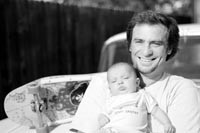Lifers: Generations of Skateboarders
“Lifers: Generations of Skateboarders Keep On Rolling”
By Katy Dang
Boise Weekly | July 2, 2008
https://www.boiseweekly.com/boise/lifers/Content?oid=937239

Photo by Francis Delapena
In 1976, skateboarding world champion Russ Howell was the guest on the television show Tell the Truth. When asked by the host what he thought would happen to his skateboarding career when he grew up, Howell replied, “Old skateboarders never die; they just roll a little slower.” He was 26 at the time.
Now nearing 59, Howell’s words have proven to be untrue; as it turns out, they don’t roll any slower.
Generations of skateboarders keep on trucking. Any notion that these individuals would grow out of the sport or give up their hobby as a childish activity has been proven wrong by their ongoing commitment to skateboarding. While they may have different degrees of participation, ideas of where the sport should go, and levels of experience within the industry, they share one common thread: they love the feel of the carve.
Like the surfing that first inspired the sport, skateboarding has endured a series of crests and crashes. There was the surfer’s toy of the late ’60s and the freestyle competitions of the ’70s, the vert ramps of the ’80s and the street skating of the ’90s, and the renaissance of each of these styles in the X-Games. The resurgence of skate parks with terrain for all types of skateboarding has led to increased interest and participation by skateboarders of all ages.
Boise is home to a few famous skateboarders. Howell and Steve Schneer have lived here since the early ’90s. Howell has shown what one man can do for the sport. He began skateboarding in 1958, when it was just one of several beach-oriented sports that flourished in Southern California.
“I can’t ever remember not skateboarding,” Howell says.
He started competing in 1965, excelling at freestyle moves that could be performed on a flat surface like handstands, nose-wheelies and 360s. Howell set the world record for the number of 360s performed on a skateboard: 163. In the 1970s, he graced the cover of Lifemagazine, performing a handstand on a skateboard, and his white-blond, flowing locks and tanned physique gave the world a real-life image of the beach boy with a talent for sidewalk surfing. In a competition in 1975, Howell was the oldest participant, at 25.
“The kids were calling me grandpa back then,” he says. “The nickname stuck.”
A physical education major in college, Howell is a proponent of the sport as a way to experience life through physical participation. He has worked toward gaining recognition for skateboarding as an activity that requires discipline, balance and fitness.
Although he was a world champion, Howell emphasizes the Olympic ethic that it is not the winning but the taking part that is important. Indeed, Howell has always contended that skateboarding should be an Olympic sport, and has traveled the world as an ambassador for skateboarding.
Schneer, 46, is of the generation that came up after Howell’s. “I have absolutely no idea what got me into it,” he says.
Schneer does remember that “no pair of rollerskates was safe in our house” in the early ’70s, when he was around 11 years old. Schneer rode freestyle in competitions around his home in Southern California, and Howell was a hero of his. In a recent move, Schneer found the acceptance letter from his first sponsor, Hobie, dated 1973. He won the under-13 age group in his first contest at Jack Murphy Stadium in 1975.
Schneer grew up in the age of urethane wheels and the first wave of concrete skate parks, where he got into skating banks and half-pipes. Control of the board changed completely with the introduction of urethane wheels, and skateboarders found a plethora of new places and ways to ride their boards.
Soon, it was less about flat surfaces and more about riding empty swimming pools and building ramps, anything to be able to ride the board vertical to the ground.
Schneer rode professionally throughout the ’80s, and was part of the vert scene that included Christian Hosoi, Gator and Tony Hawk. He moved to Boise in 1991.
“It was done, for me, at that point,” he says.
Vert skating was on its way out. The original skate parks had all closed due to liability issues. Schneer didn’t skateboard again until 1995, when the Vans Warped tour came to Boise. They had a huge half pipe ramp, so he grabbed his board and his pads and went out to see his old friends. For a while, he only skated once a year, but the increase in parks with big terrain like Hailey and McCall have begun tempting him.
The longest that Boise resident Tom Kilroy has been off a board in the last 30 years is one month. Kilroy got his start skating in 1975 outside of Chicago and got his first real board in 1978. He has been riding ever since.
“That first turn is what got me,” says Kilroy. “The carve just felt so good.” It is the transcendent quality of skateboarding that keeps him interested. “When you’re skateboarding, you can’t think about anything else but skateboarding,” he says.
Kilroy stayed with the sport through its ups and downs, and has been inspired by the recent spate of new skate parks in the Northwest.
“Even the parks that aren’t that good are better than what we had as kids, and certainly better than nothing,” he says.
Kilroy was taking his daughter to art class at Fort Boise in 2002 when he saw the skate park there. He went out with his old vert board, wearing Dockers. “The kids thought I was riding an ironing board,” he says. He fell off, tore his pants and skinned his knee. “It felt great.”
Both Howell and Schneer have been sponsored by some of the biggest names in the industry, and both still have signature pro boards. Howell’s is a freestyle board by Decomposed, and Schneer’s is a replica of his favorite shape from 1989 by a company called Shipwrecked. In a nod to Schneer’s famous trick, the Ho-Ho, the board features pirate graphics done by Boise artist Sean Wyatt, and bears the pirate slogan “Yo-Ho-Ho.”
Kilroy was recently sponsored, at age 43, by the Old Man Army, a loose-knit community of older skaters whose motto is “Established before you were born.” Their Web site highlights the talents of life-long skaters, with the statement that, “Chances are if you’re over 30, you didn’t start skating last week.”
The perception that skateboarding is something that you only do when you’re young is changing by the continued presence of lifelong skaters. “It’s not really different than skiing or biking,” says Kilroy.
“That’s the beauty of skateboarding,” says Paul Whitworth, owner of Prestige Skateshop and a Boise native who has been skating for 20 years. “It fits so many demographics. There is no real age differentiation, because we’re all out there for the same reason: we just love skateboarding.”
There will be more and more older skaters in the coming years, and the presence of parent/child pairs at skate parks continues to increase. Legend has it that at a recent competition, three generations of the same family competed against each other.
The winner was the grandfather.



